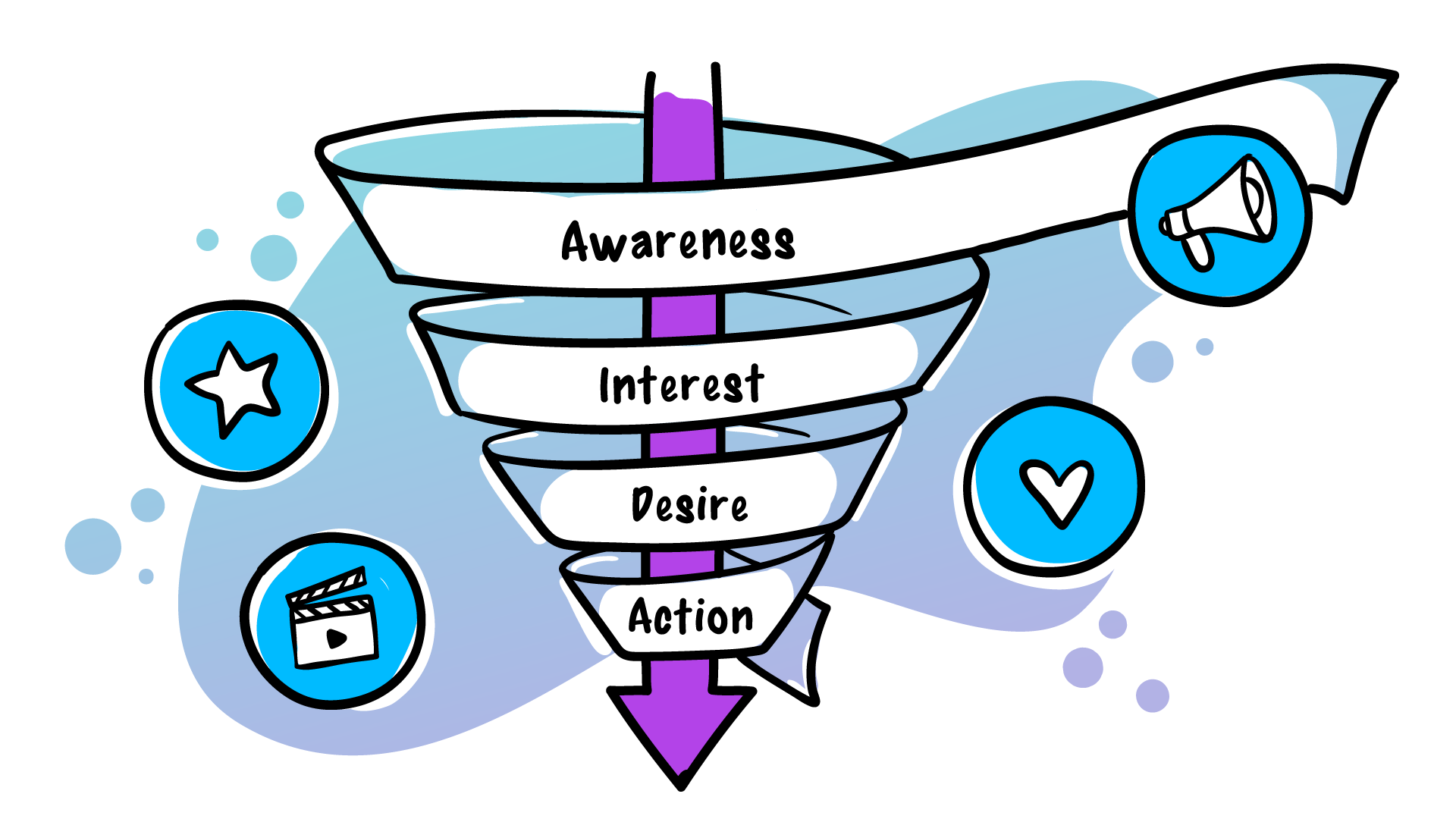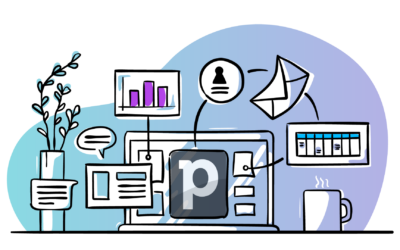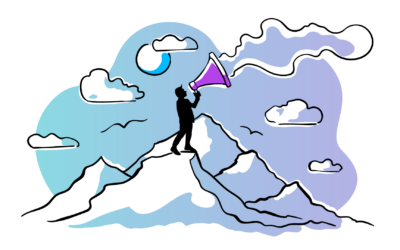Last updated: Sept 19th 2025
Turning prospects into loyal customers can feel like navigating a maze—especially in B2B.
The term “marketing funnel” gives you a map. It’s one we’ve used quite a bit on this blog, but we’ve never taken the time to unpack what it actually means—until now.
This post is your go-to guide to understanding the marketing funnel: what it is, how it works in B2B marketing, and how to build one using the customer engagement data already sitting in your CRM and marketing tools.
TOPICS WE’LL COVER
What is a marketing funnel? A guiding explainer for all
A marketing funnel is a visualization model or framework illustrating the process by which prospects transition into customers and beyond.
The term “marketing” is pivotal here as it emphasizes the role of marketing strategies and efforts in guiding prospects through this journey. It’s about creating awareness, sparking interest, and nurturing relationships, leading to conversions and, even better, advocacy.
Now, why is it pictured as a “funnel”?
Imagine a physical funnel, wide at the top and narrow at the bottom. Similarly, the marketing funnel starts wide with many individuals at the awareness stage. As they move down through the stages of interest, consideration, and decision, their numbers decrease, but their engagement and likelihood to convert increase. The shape of a funnel perfectly illustrates this process of narrowing down from a large pool of potential customers to a smaller group of committed ones.
The coupling of “marketing” and “funnel” isn’t just a catchy phrase; it encapsulates a fundamental process in customer acquisition and retention.
“Marketing” is about communicating value to prospective customers, while “funnel” visualizes the journey these prospects take towards becoming customers. When married, they depict a structured journey underpinned by strategic marketing efforts at every phase to ensure a smooth transition from one stage to the next, leading to the desired goal of conversion and beyond.
8 benefits of leveraging the marketing funnel model
Why should the marketing funnel model matter to you? Because embracing it is more than a choice; it’s a strategic move that transforms your approach to customer acquisition and retention. Let’s delve deeper into some notable benefits of integrating this powerful framework into your marketing strategy.
#1 Helps you build a clearer, more focused B2B marketing strategy
Building a cohesive B2B marketing strategy can be daunting, especially with scattered channels and unclear lead paths.
With a marketing funnel, you can streamline your strategy development process, ensuring that every step aligns with your overall objectives. This simplification leads to a more focused and effective approach to marketing.
Say you’re a B2B SaaS firm selling employee management software to HR departments. After incorporating the marketing funnel, you discover that most upgrades occur after prospects attend a webinar session focused on employee engagement features and their benefits.
What do you do? Double down on creating and promoting similar webinar content, refining it even further, and voila! You see a significant uptick in paid subscriptions.
#2 Improves budget allocation
Allocating budget without funnel insights often leads to wasted spend—especially when B2B buyers require longer nurture paths.
The marketing funnel model assists you in allocating your resources more efficiently.
Consider a cybersecurity solutions startup. They initially disperse funds across social media, SEO, and trade shows. However, funnel analysis reveals that most high-value leads actually come from targeted LinkedIn articles about cybersecurity in today’s remote work landscape. The logical next step? Reallocate the budget toward producing these high-impact LinkedIn articles.
#3 Streamlines marketing and sales team alignment
Determining who should interact with lead data at a certain point is often a source of confusion and misalignment between marketing and sales teams.
Having a marketing funnel for your business clarifies the roles and stages at which both teams should engage with potential customers. It greatly helps to increase marketing and sales alignment.
For example, imagine you have a prospect named Alex who enters your marketing funnel by signing up for your monthly email newsletter. As Alex receives your newsletters, each interaction, such as opened emails and clicked links, is tracked by your email marketing tool. Now, your marketing and sales team have together defined a lead scoring model to assign scores for such interactions and also the criteria for which events and score levels will make a lead an MQL (marketing qualified lead) and ready to be passed on to sales.
In essence, with the combination of lead scoring and the marketing funnel concept, you’ve established a data-driven system for orchestrating the marketing-to-sales handoff.
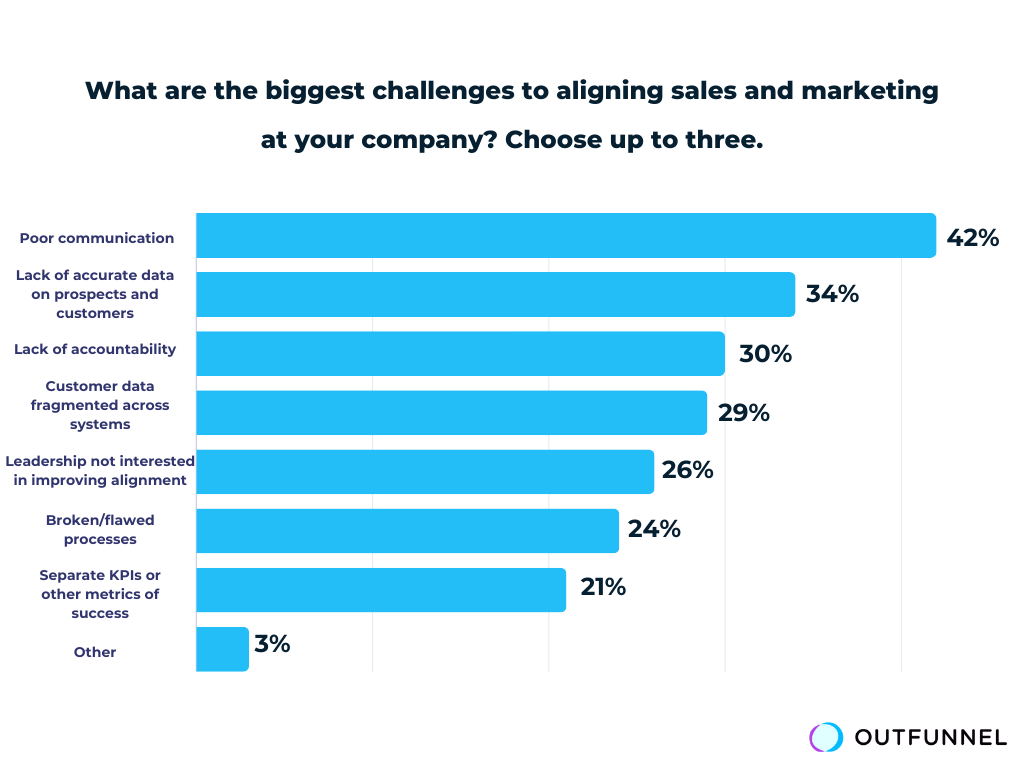
#4 Turns marketing metrics into business-driving insights
You’ve got all kinds of numbers – clicks, views, you name it. But what do they really mean? Most of the time, these numbers look good but don’t actually help you understand your business better.
A solid marketing funnel model helps you cut through the clutter and focus on what truly matters. Each stage of the funnel serves as a mini-milestone, helping you create tailored metrics that make sense for your business. No more patting yourself on the back for a high number of page views or email opens if they don’t result in meaningful interactions or sales.
For example, with the funnel framework, you shift your attention to more significant metrics like the number of MQLs generated each month or the MQL-to-Lead conversion ratio. These metrics offer direct insights into the health of your marketing initiatives and indicate where adjustments are needed.
#5 Optimizes content strategy
A marketing funnel gives you a framework for creating content that directly addresses the needs of your audience at each stage. You’re not just throwing spaghetti at the wall and seeing what sticks. Instead, you’re crafting targeted messages that move leads closer to conversion.
For example, at the “Awareness” stage, you might use blog posts or educational videos to attract a broad audience. As leads move to the “Consideration” stage, you can offer more in-depth webinars or case studies that help them understand why your solution is the best fit for their needs.
#6 Shortens sales cycles
A streamlined marketing funnel can also significantly shorten the sales cycle. By providing the right content and interactions at each stage, you speed up the decision-making process for your leads. Faster decisions mean quicker sales and more efficient use of your team’s time.
For example, if you identify that a lot of customers decide to purchase after watching a product demo, you can make sure to feature the demo early in your engagement with potential customers. No more beating around the bush; you go straight for what works.
#7 Increases customer lifetime value (CLV)
Getting a customer is great, but keeping them is where the real value lies. A marketing funnel helps you nurture the customer relationship post-purchase, leading to higher CLV. Essentially, you’re not just going for the one-time sale; you’re looking to maximize revenue from each customer over time.
For example, let’s say you sell office supplies. After someone makes a purchase, they enter a new “retention” stage in your funnel. Here, they get automated emails with special offers on ink and paper, two things they’ll likely need again. This upsell strategy keeps them coming back for more, increasing their CLV.
#8 Strengthens crisis management
Believe it or not, a marketing funnel can even help you in times of crisis. How? By giving you a structured system to fall back on, you can more easily identify problem areas and pivot strategies quickly. Whether it’s a sudden change in market demand or a global pandemic, having a solid funnel in place can be your guiding light.
For example, let’s say a new competitor enters the market and starts taking your market share. Your funnel analytics might show a drop in conversions at the “Interest” stage. This alerts you to re-evaluate your unique selling proposition (USP) or perhaps introduce timely offers to entice prospects to choose you over the competition.
Types of marketing funnels: No one funnel to rule them all
Not all funnels are created equal—especially in B2B. Some help generate brand awareness. Others go deeper, helping you convert leads and grow customer lifetime value.
Below are three popular marketing funnel models, each with a different scope. While AIDA and TOFU/MOFU/BOFU focus on lead generation, the customer experience funnel helps you go beyond the sale—something B2B marketers often overlook.
1. The Elias St. Elmo Lewis AIDA Funnel Model: The OG marketing funnel
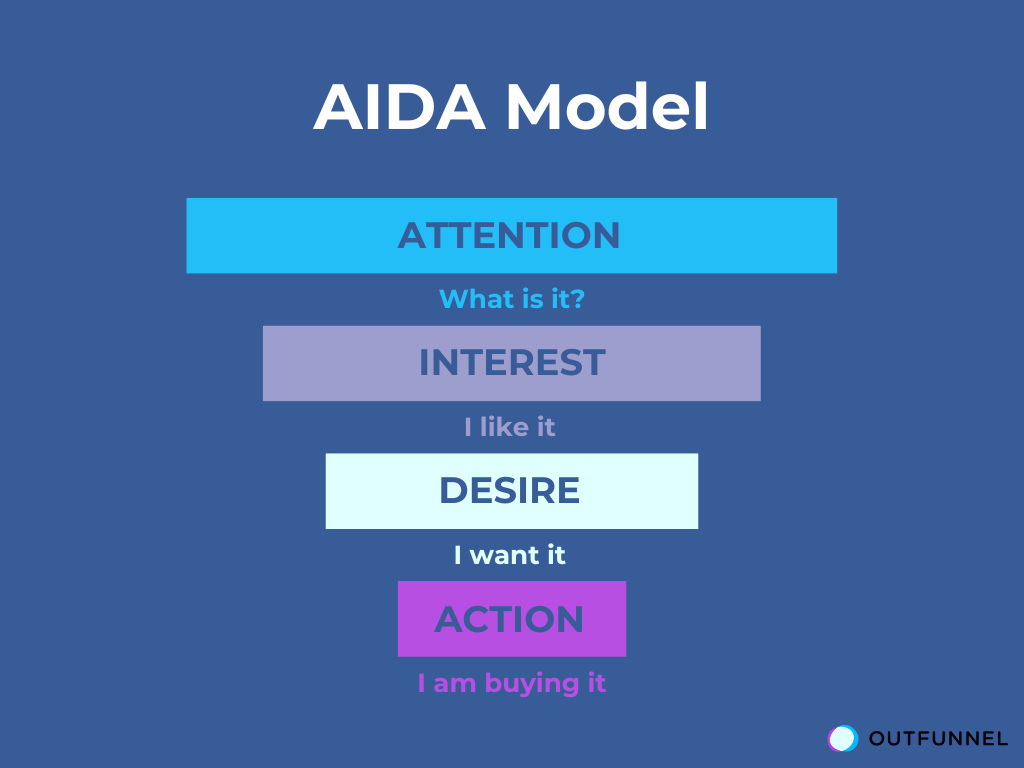
Ah, the AIDA model – the one that started it all. Elias St. Elmo Lewis gifted us with this simple yet powerful framework ages ago (1898 is what the internet claims), and guess what? It’s so pervasive in its mentions and straightforward that many folks straight-up consider it “the marketing funnel.” No kidding.
Now, let’s slice and dice the AIDA stages with a relatable example – the process of buying digital whiteboarding software as a remote marketing team:
- Awareness: One of the team members comes across a digital whiteboarding software while browsing a productivity blog during their personal time. Intrigued by the brand, they mention it in a casual team chat.
- Interest: The suggestion piques interest, and a few team members start to follow the brand on social media. They even sign up for a newsletter to keep tabs on updates and best practices.
- Desire: Over time, the brand keeps popping up in industry conversations and social feeds. Team members start reading reviews and blog posts about the software.
- Action: The tech-savvy team member initiates a group planning session using the digital whiteboarding software. The session is a hit, revealing the tool’s value to everyone. After a few weeks of using the free version, the team collectively decides to upgrade to a paid plan.
Simple, isn’t it? Each stage of AIDA zeroes in on a specific part of the customer’s journey but ties it all together, seamlessly guiding them from recognizing a problem to finding the desired solution.
2. ToFu, MoFu, and BoFu marketing funnel: A 3-stage journey from awareness to decision
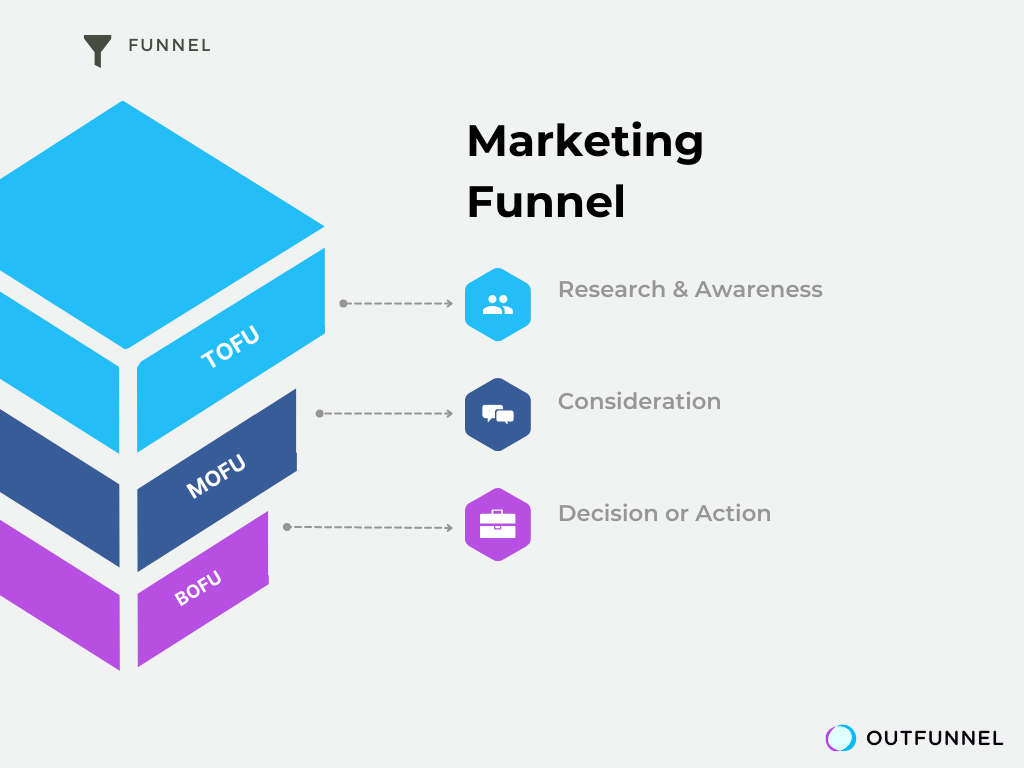
Like the AIDA model, the ToFu, MoFu, and BoFu marketing funnel follows a similar journey scope, covering the path from awareness to purchase. However, there are some key differences in terms of the number of stages and what each stage encompasses.
Many businesses favor the ToFu, MoFu, and BoFu model because of its three-stage structure, which is easy to follow and implement. Let’s break down these stages with the help of an example:
- ToFu (Top of funnel – Awareness): At this initial stage, customers become aware of a problem or need in their lives. They begin exploring various solution categories related to this problem. For example, someone dealing with back pain might search for “how to cure back pain” or “most effective back pain solutions.”
- MoFu (Middle of funnel – Consideration): Moving along the funnel, customers are now aware of your brand and its position within the solution category they are interested in. They recognize your brand as a potential answer to their problem within that category. In our back pain scenario, they might search for “best back pain therapists near me” and come across your clinic..
BoFu (Bottom of funnel – Decision): Finally, at the bottom of the funnel, customers have narrowed down their options to a shortlist of therapists. They are actively comparing these options – analyzing factors like features, pricing and reviews to make the final decision. For instance, they may search for “X therapist review” or “X vs Y” to thoroughly evaluate their choices before committing.
3. The Customer Experience Funnel: Moving beyond the initial sale
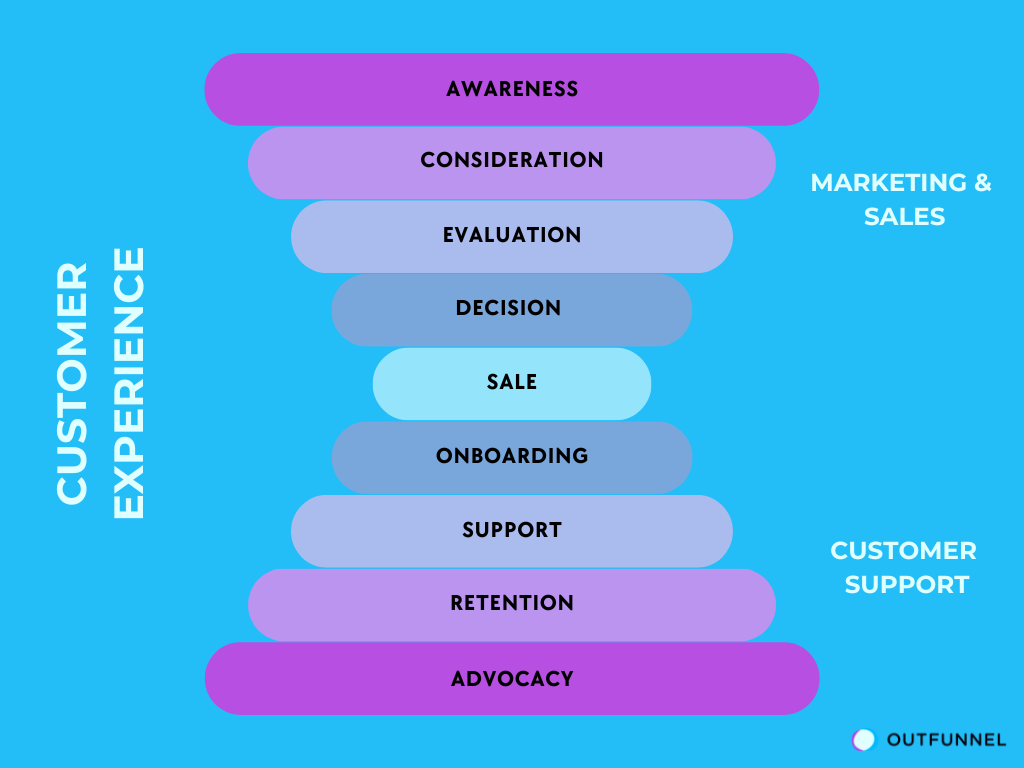
Traditional funnels like AIDA stop at the point of purchase. That works for eCommerce—but in B2B, the real ROI comes after the sale. That’s why the Customer Experience Funnel (or hourglass model) is so powerful: it extends the funnel beyond the transaction, helping you nurture long-term value and advocacy.
How does the “hourglass” shape form?
The top funnel brings in new customers and funnels them down to make a purchase. After that, the bottom funnel focuses on keeping those customers happy. These happy customers then become advocates, widening the bottom funnel and naturally attracting more newcomers at the top. The shape starts wide, narrows at the sale, and widens out again at the bottom, forming an hourglass shape. That makes sense, right?
Alright, let’s dive into the nitty-gritty of the hourglass-shaped customer experience funnel. First, a quick heads-up – the top half of the hourglass – the combination of awareness, consideration, and decision stages pretty much mirrors the ToFu, MoFu, and BoFu model we talked about.
So, here is a quick rundown of them using a SaaS business as an example:
- Awareness: People find your blog post about “better team communication” when they’re searching for ways to work better online.
- Consideration: Now, they know you have a tool to help with this. They might even try your free 14-day trial plan to see how good it is compared to others.
- Decision: They love your unique features, read some customer case studies, find the pricing suitable and decide to buy your pro plan.
Now, let’s delve into the post-sale stages in more detail:
- Onboarding: After the initial purchase, customers often have high hopes but might also feel a bit lost. The onboarding process should get rid of any uncertainty, showing them they made the right choice. Tip – Send a welcome email that’s not just warm but also super useful. Include quick-start guides and a beginner’s tutorial video. Add a list of resources where they can find extra help. Basically, make them go, “Wow, I’m already getting value from this!”
- Support and retention: This is when you’ve got to keep those customers happy and coming back for more. If problems pop up, you should solve them pronto to build trust. Tip – Have multiple customer support channels like chat and email so they can reach out how they like. Quick responses and real solutions make customers think, “Hey, they’ve got my back!”
- Expansion: Your customers like what they see. Now’s your chance to offer them more of your amazing stuff. Tip – Use data to understand what else your product users might need, then shoot them an email about an add-on or higher-tier plan that can bring them extra value. A well-timed offer can have them thinking, “More of a good thing? Why not!”
- Advocacy: Your customer loves your video tool and can’t stop talking about it. Time to make them feel extra special. Tip – Introduce them to your referral program that gives them cool stuff like additional storage or access to beta features. This way, they’ll want to tell even more people how awesome your product is.
The customer experience funnel is all about long-term relationships. It keeps customers engaged from the first interaction to becoming loyal advocates. With this funnel model, you’re on track for both short-term gains and long-term success.
Alright, now that we’ve got the foundational funnel models sorted, let’s move on to what else you need to know to apply the marketing funnel concept.
What are marketing funnel metrics?
Marketing funnel metrics are the key performance indicators (KPIs) that help you track how well your leads move through each stage of the funnel—from awareness to decision.
Here’s how to think about funnel metrics stage by stage:
Awareness Stage Metrics
These tell you how many people are discovering your brand.
- Website traffic – Are people visiting your site?
- Social media engagement – Are they liking, sharing, or commenting on your content?
- Content reach – How far are your blog posts, videos, or ads spreading?
These metrics help you assess how well your marketing efforts are generating interest and visibility.
Consideration Stage Metrics
These show how effectively you’re nurturing leads and keeping their attention.
- Click-through rate (CTR) – Aim for 5–10% as a healthy range.
- Email open rate – 20% is a common benchmark.
- Downloads & signups – eBooks, guides, or webinar registrations are great indicators.
- Social shares – Are people sharing your content or engaging in more meaningful ways?
At this stage, you’re measuring engagement depth—not just reach.
Decision Stage Metrics
These measure how well you’re converting leads into customers.
- Lead conversion rate – Often 15–20% for qualified leads.
- Sales conversion rate – Around 5% is typical, depending on the industry.
- Return on investment (ROI) – A solid funnel often sees 300%+ ROI on marketing efforts.
These metrics directly tie your marketing to revenue and business outcomes.
By tracking the right metrics at each stage, you’ll not only improve funnel performance—you’ll understand where leads get stuck, and what to optimize next.
Marketing funnel vs. related terms: How do they differ?
In the world of marketing, terminology can sometimes blur together, leading to confusion. Let’s break down the distinctions between some terms that get confused with marketing funnel:
Marketing funnel vs. Sales funnel
Marketing funnel: This is a broad concept that encompasses the entire journey of a potential customer, starting from awareness and leading to conversion and beyond. It focuses on the customer’s progression through marketing efforts.
Sales funnel: In contrast, the sales funnel is a narrower subset of the marketing funnel. It specifically zooms in on the stages directly related to closing a sale. This includes activities like lead qualification, proposal presentation, and the actual purchase. The sales funnel is primarily sales-focused, outlining the steps that lead to a successful sale.
Marketing funnel vs. Brand funnel
In funnel marketing, every new user is seen as a potential customer at the outset of their journey. In contrast, brand marketing is about treating new users as potential advocates who can help amplify the company’s message. A marketing funnel focuses on the sales and conversion process, while a brand funnel assesses brand perception and loyalty.
Marketing funnel vs. Customer journey
Marketing funnel: The marketing funnel is a strategic model outlining the stages a potential customer goes through. It primarily emphasizes how marketing efforts influence and guide a purchase decision, from awareness to conversion.
Customer journey: On the other hand, the customer journey is a comprehensive term that encompasses all interactions and touchpoints a customer has with a brand throughout their entire lifetime. This includes marketing, sales, customer service, and post-purchase interactions. It provides a holistic view of the customer’s entire experience with the brand.
Marketing funnel vs. Marketing flywheel
With the introduction of the flywheel model, many consider it fundamentally different from traditional marketing funnels like AIDA or TOFU. And rightfully so, because when compared to these linear models, the flywheel stands as a symbol of continuous engagement and customer-centricity.
However, here’s where the plot thickens. If the marketing funnel you’re referring to happens to be the customer experience funnel or the hourglass funnel, suddenly, the lines blur. The flywheel and these modern funnel models share common ground in their emphasis on ongoing customer engagement, retention, and loyalty.
So, in conclusion, the difference between the marketing funnel and the marketing flywheel exists, but it’s not a one-size-fits-all scenario. It hinges on which foundational marketing funnel you choose for comparison.
How to create your own marketing funnel? Your existing customer data holds the key
The most effective marketing funnels aren’t copied from templates—they’re built from your own customer data.
If you’re using tools like Mailchimp, Zoom, or ActiveCampaign, your CRM is likely filled with untapped behavioral data. The key is connecting the dots—bringing those insights together to understand how real buyers are moving through your funnel.
That’s where Outfunnel comes in. It syncs your marketing engagement data (email clicks, webinar attendance, ad views) directly into your CRM—so you can build and analyze your funnel in one place.
Let’s say you use Mailchimp to send updates to email subscribers and Zoom for conducting webinar sessions. With Outfunnel, you can bring the behavioral data from various sales and marketing tools into your CRM (say you use Pipedrive) and build your funnel model. Similarly, think about the possibility of bringing other behavioral data into your CRM as well, like which pages are viewed, which ads are clicked, and so on.
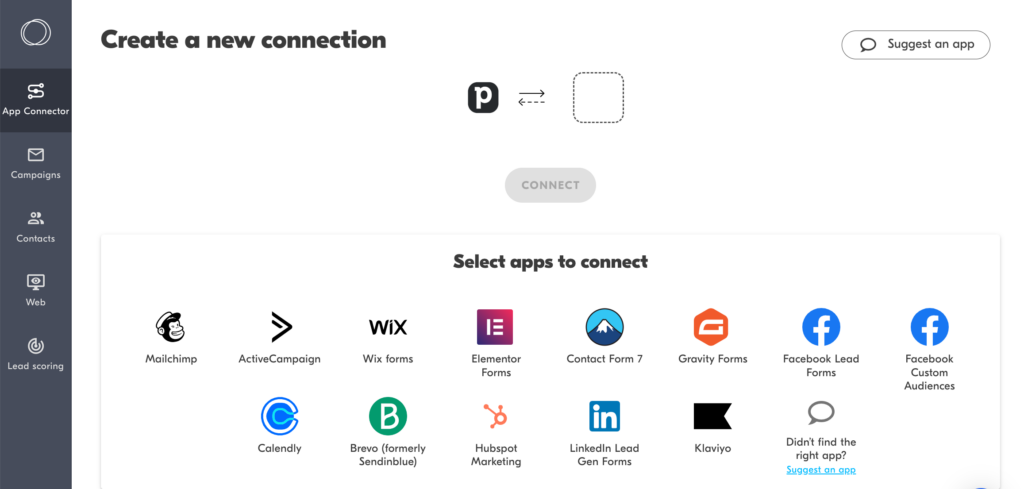
With all the meaningful behavioral data from both existing customers and leads in your CRM, you can do two important things – first, build a model that reflects how your customers converted and use this model to locate prospects in your funnel and optimize their interactions with your business for improving conversion rates.
This approach of transforming customer data into a funnel model surpasses adopting any pre-existing funnel blindly. It empowers you to understand every stage of the customer journey, allowing you to take strategic actions at each step to drive better results.
Wrapping up
In this comprehensive exploration of the marketing funnel concept, we’ve covered its definition, benefits, and different types, including the classic AIDA model, ToFu, MoFu, BoFu, and the customer experience funnel. We’ve also clarified the distinctions between the marketing funnel and related terms like the sales funnel, customer journey, and the marketing flywheel.
Finally, we’ve highlighted how leveraging your customer data can help you create a better, data-driven marketing funnel.
Start bringing your sales and marketing data together with Outfunnel’s 14-day free trial
FAQs about the marketing funnel
What is a B2B marketing funnel?
A B2B marketing funnel is a visual representation of the stages a business-to-business (B2B) customer goes through before making a purchase. The funnel helps businesses understand and optimize their marketing strategies for each stage of this journey. Think of it as your dynamic blueprint to win over clients.
What is the difference between B2B and B2C marketing funnels?
The difference between B2B and B2C marketing funnels lies in the target audience and the complexity of the buying process. While both aim to convert leads into customers, B2B funnels typically involve longer, more intricate sales cycles, often requiring personalized nurturing to win business clients. In contrast, B2C funnels cater to shorter, more direct purchasing decisions made by individual consumers.

